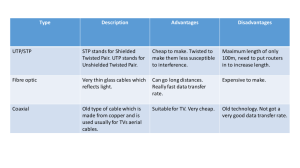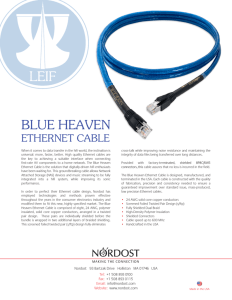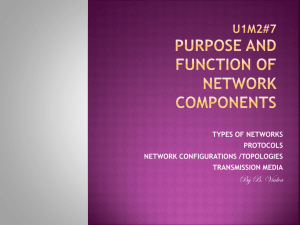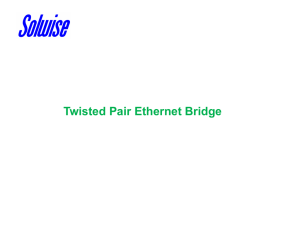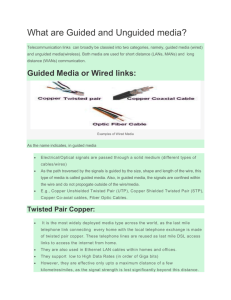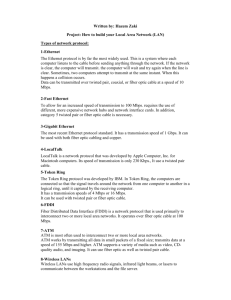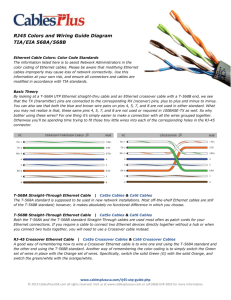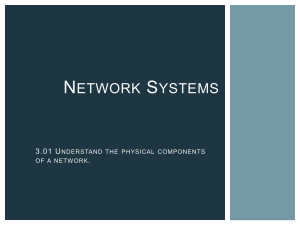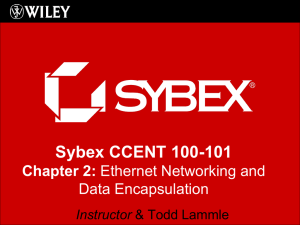Computer Networking 7.1 What Is Computer
advertisement
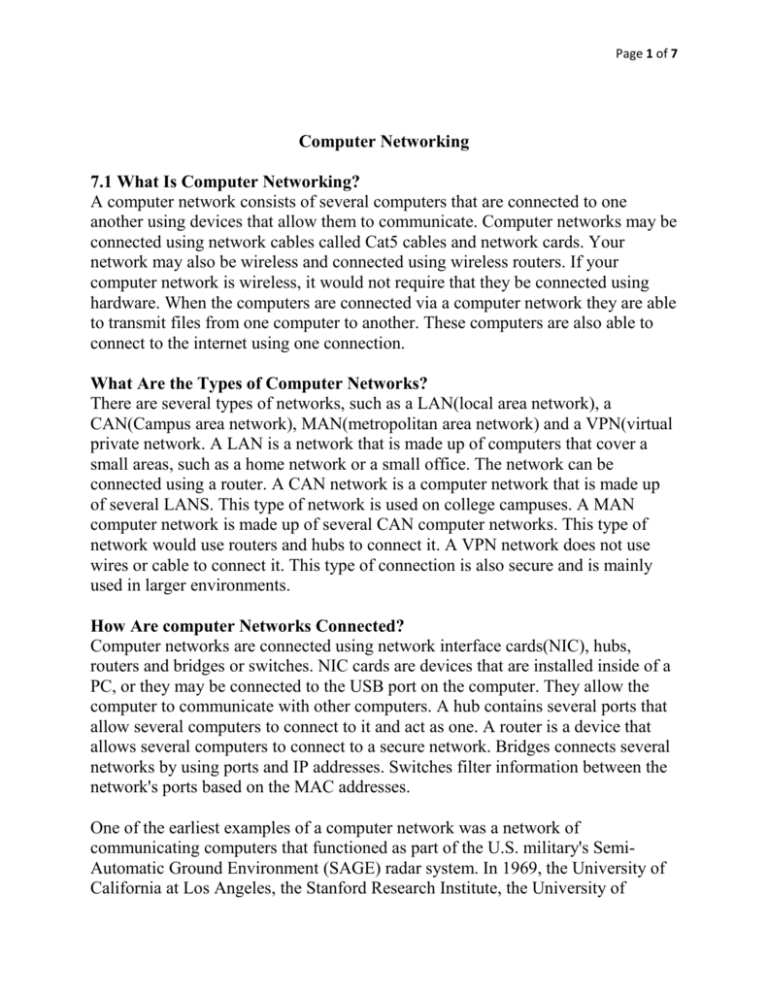
Page 1 of 7 Computer Networking 7.1 What Is Computer Networking? A computer network consists of several computers that are connected to one another using devices that allow them to communicate. Computer networks may be connected using network cables called Cat5 cables and network cards. Your network may also be wireless and connected using wireless routers. If your computer network is wireless, it would not require that they be connected using hardware. When the computers are connected via a computer network they are able to transmit files from one computer to another. These computers are also able to connect to the internet using one connection. What Are the Types of Computer Networks? There are several types of networks, such as a LAN(local area network), a CAN(Campus area network), MAN(metropolitan area network) and a VPN(virtual private network. A LAN is a network that is made up of computers that cover a small areas, such as a home network or a small office. The network can be connected using a router. A CAN network is a computer network that is made up of several LANS. This type of network is used on college campuses. A MAN computer network is made up of several CAN computer networks. This type of network would use routers and hubs to connect it. A VPN network does not use wires or cable to connect it. This type of connection is also secure and is mainly used in larger environments. How Are computer Networks Connected? Computer networks are connected using network interface cards(NIC), hubs, routers and bridges or switches. NIC cards are devices that are installed inside of a PC, or they may be connected to the USB port on the computer. They allow the computer to communicate with other computers. A hub contains several ports that allow several computers to connect to it and act as one. A router is a device that allows several computers to connect to a secure network. Bridges connects several networks by using ports and IP addresses. Switches filter information between the network's ports based on the MAC addresses. One of the earliest examples of a computer network was a network of communicating computers that functioned as part of the U.S. military's SemiAutomatic Ground Environment (SAGE) radar system. In 1969, the University of California at Los Angeles, the Stanford Research Institute, the University of Page 2 of 7 California at Santa Barbara and the University of Utah were connected as part of the Advanced Research Projects Agency Network (ARPANET) project. It is this network that evolved to become what we now call the Internet. Networks are used to: • • • • • Facilitate communication via email, video conferencing, instant messaging, etc. Enable multiple users to share a single hardware device like a printer or scanner Enable file sharing across the network Allow for the sharing of software or operating programs on remote systems Make information easier to access and maintain among network users There are many types of networks, including: • • • • • • • • • • • Local Area Networks (LAN) Personal Area Networks (PAN) Home Area Networks (HAN) Wide Area Networks (WAN) Campus Networks Metropolitan Area Networks (MAN) Enterprise Private Networks Internet works Backbone Networks (BBN) Global Area Networks (GAN) The Internet A computer network or data network is a telecommunications network that allows computers to exchange data. In computer networks, networked computing devices pass data to each other along data connections. Data is transferred in the form of packets. The connections (network links) between nodes are established using either cable media or wireless media. The best-known computer network is the Internet. Page 3 of 7 Network computer devices that originate, route and terminate the data are called network nodes. Nodes can include hosts such as personal computers, phones, servers as well as networking hardware. Two such devices are said to be networked together when one device is able to exchange information with the other device, whether or not they have a direct connection to each other. Computer networks support applications such as access to the World Wide Web, shared use of application and storage servers, printers, and fax machines, and use of email and instant messaging applications. Computer networks differ in the physical media used to transmit their signals, the communications protocols to organize network traffic, the network's size, topology and organizational intent. Today, computer networks are the core of modern communication. All modern aspects of the public switched telephone network (PSTN) are computer-controlled. Telephony increasingly runs over the Internet Protocol, although not necessarily the public Internet. The scope of communication has increased significantly in the past decade. This boom in communications would not have been possible without the progressively advancing computer network. Computer networks, and the technologies that make communication between networked computers possible, continue to drive computer hardware, software, and peripherals industries. The expansion of related industries is mirrored by growth in the numbers and types of people using networks, from the researcher to the home user. 7.2 History The following is a chronology of significant computer network developments: In the late 1950s, early networks of communicating computers included the military radar system Semi-Automatic Ground Environment (SAGE). In 1960, the commercial airline reservation system semi-automatic business research environment (SABRE) went online with two connected mainframes. In 1962, J.C.R. Licklider developed a working group he called the "Intergalactic Computer Network", a precursor to the ARPANET, at the Advanced Research Projects Agency (ARPA). In 1964, researchers at Dartmouth developed the Dartmouth Time Sharing System for distributed users of large computer systems. The same year, at Massachusetts Institute of Technology, a research group supported by General Electric and Bell Labs used a computer to route and manage telephone connections. Page 4 of 7 Throughout the 1960s, Leonard Kleinrock, Paul Baran, and Donald Davies independently developed network systems that used packets to transfer information between computers over a network. In 1965, Thomas Marill and Lawrence G. Roberts created the first wide area network (WAN). This was an immediate precursor to the ARPANET, of which Roberts became program manager. Also in 1965, the first widely used telephone switch that implemented true computer control was introduced by Western Electric. In 1969, the University of California at Los Angeles, the Stanford Research Institute, the University of California at Santa Barbara, and the University of Utah were connected as the beginning of the ARPANET network using 50 kbit/s circuits. In 1972, commercial services using X.25 were deployed, and later used as an underlying infrastructure for expanding TCP/IP networks. In 1973, Robert Metcalfe wrote a formal memo at Xerox PARC describing Ethernet, a networking system that was based on the Aloha network, developed in the 1960s by Norman Abramson and colleagues at the University of Hawaii. In July 1976, Robert Metcalfe and David Boggs published their paper "Ethernet: Distributed Packet Switching for Local Computer Networks" and collaborated on several patents received in 1977 and 1978. In 1979, Robert Metcalfe pursued making Ethernet an open standard. In 1976, John Murphy of Datapoint Corporation created ARCNET, a token-passing network first used to share storage devices. In 1995, the transmission speed capacity for Ethernet was increased from 10 Mbit/s to 100 Mbit/s. By 1998, Ethernet supported transmission speeds of a Gigabit. The ability of Ethernet to scale easily (such as quickly adapting to support new fiber optic cable speeds) is a contributing factor to its continued use today. Properties Computer networking may be considered a branch of electrical engineering, telecommunications, computer science, information technology or computer engineering, since it relies upon the theoretical and practical application of the related disciplines. A computer network facilitates interpersonal communications allowing people to communicate efficiently and easily via email, instant messaging, chat rooms, telephone, video telephone calls, and video conferencing. Providing access to Page 5 of 7 information on shared storage devices is an important feature of many networks. A network allows sharing of files, data, and other types of information giving authorized users the ability to access information stored on other computers on the network. A network allows sharing of network and computing resources. Users may access and use resources provided by devices on the network, such as printing a document on a shared network printer. Distributed computing uses computing resources across a network to accomplish tasks. A computer network may be used by computer Crackers to deploy computer viruses or computer worms on devices connected to the network, or to prevent these devices from accessing the network (denial of service). A complex computer network may be difficult to set up. It may be costly to set up an effective computer network in a large organization. Network packet Main article: Network packet Most information in computer networks is carried in packets. A network packet is a formatted unit of data (a list of bits or bytes) carried by a packet-switched network. Computer communications links that do not support packets, such as traditional point-to-point telecommunications links, simply transmit data as a bit stream. When data is formatted into packets, the bandwidth of the communication medium can be better shared among users than if the network were circuit switched. A packet consists of two kinds of data: control information and user data (also known as payload). The control information provides data the network needs to deliver the user data, for example: source and destination network addresses, error detection codes, and sequencing information. Typically, control information is found in packet headers and trailers, with payload data in between. Network topology Main article: Network topology The physical layout of a network is usually less important than the topology that connects network nodes. Most diagrams that describe a physical network are therefore topological, rather than geographic. The symbols on these diagrams usually denote network links and network nodes. Network links Page 6 of 7 The communication media used to link devices to form a computer network include electrical cable (HomePNA, power line communication, G.hn), optical fiber (fiber-optic communication), and radio waves (wireless networking). In the OSI model, these are defined at layers 1 and 2 — the physical layer and the data link layer. A widely adopted family of communication media used in local area network (LAN) technology is collectively known as Ethernet. The media and protocol standards that enable communication between networked devices over Ethernet are defined by IEEE 802.3. Ethernet transmit data over both copper and fiber cables. Wireless LAN standards (e.g. those defined by IEEE 802.11) use radio waves, or others use infrared signals as a transmission medium. Power line communication uses a building's power cabling to transmit data. Wired technologies Fiber optic cables are used to transmit light from one computer/network node to another The orders of the following wired technologies are, roughly, from slowest to fastest transmission speed. Twisted pair wire is the most widely used medium for all telecommunication. Twisted-pair cabling consist of copper wires that are twisted into pairs. Ordinary telephone wires consist of two insulated copper wires twisted into pairs. Computer network cabling (wired Ethernet as defined by IEEE 802.3) consists of 4 pairs of copper cabling that can be utilized for both voice and data transmission. The use of two wires twisted together helps to reduce crosstalk and electromagnetic induction. The transmission speed ranges from 2 million bits per second to 10 billion bits per second. Twisted pair cabling comes in two forms: unshielded twisted pair (UTP) and shielded twisted-pair (STP). Each form comes in several category ratings, designed for use in various scenarios. Coaxial cable is widely used for cable television systems, office buildings, and other work-sites for local area networks. The cables consist of copper or aluminum wire surrounded by an insulating layer (typically a flexible material with a high dielectric constant), which itself is surrounded by a conductive layer. The insulation helps minimize interference and distortion. Transmission speed ranges from 200 million bits per second to more than 500 million bits per second. Page 7 of 7 ITU-T G.hn technology uses existing home wiring (coaxial cable, phone lines and power lines) to create a high-speed (up to 1 Gigabit/s) local area network. An optical fiber is a glass fiber. It carries pulses of light that represent data. Some advantages of optical fibers over metal wires are very low transmission loss and immunity from electrical interference. Optical fibers can simultaneously carry multiple wavelengths of light, which greatly increases the rate that data can be sent, and helps enable data rates of up to trillions of bits per second. Optic fibers can be used for long runs of cable carrying very high data rates, and are used for undersea cables to interconnect continents. Price is a main factor distinguishing wired- and wireless-technology options in a business. Wireless options command a price premium that can make purchasing wired computers, printers and other devices a financial benefit. Before making the decision to purchase hard-wired technology products, a review of the restrictions and limitations of the selections is necessary. Business and employee needs may override any cost considerations.
